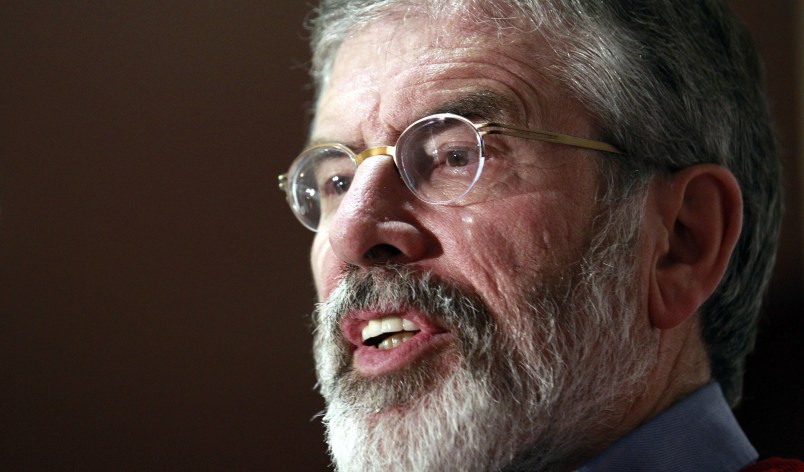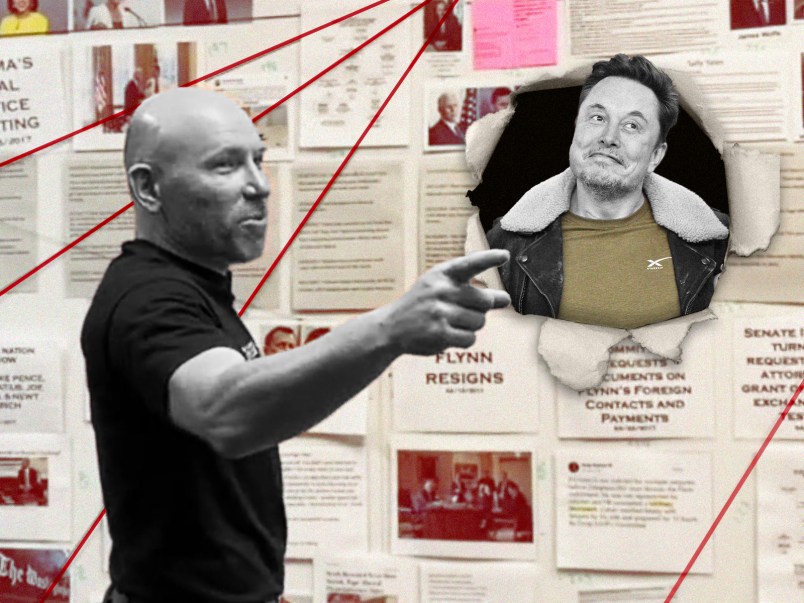DUBLIN (AP) — Sinn Fein chief Gerry Adams, the warlord-turned-peacemaker of the Northern Ireland conflict, was being interrogated Thursday over the grisly slaying of a Belfast widow that has haunted his political career for decades.
Adams was arrested on suspicion of ordering the killing of Jean McConville, a mother of 10 in his Catholic west Belfast power base in 1972. That was the deadliest year in four decades of bloodshed, when the outlawed Irish Republican Army was committing killings daily — and Adams was already a commanding figure.
The IRA branded the 38-year-old woman a British spy but killed her secretly and told her children, who ranged in age from infants to teens, that she had abandoned them.
If Adams, 65, is charged with the murder of McConville — who disappeared without trace until her bullet-shattered skull was found near a Republic of Ireland beach in 2003 — it would be a profound surprise and deal a damaging shock to Northern Ireland’s precariously balanced peace.
Adams’ track record suggests he won’t be.
He was arrested and interrogated repeatedly in the wake of IRA bombings and shootings in the 1970s and 1980s, and even met British government leaders face to face as an IRA representative for failed cease-fire talks in 1972, followed by the IRA’s biggest car-bomb offensive on Belfast. Yet he insists he’s never held any position in the underground army and has been convicted of only one IRA offense, a failed escape when imprisoned without trial.
Adams gave every impression he intended to walk free again, giving TV interviews shortly before delivering himself to a Belfast police station Wednesday to begin an interrogation he has anticipated for months, if not years.
“I believe that the killing of Jean McConville and the secret burial of her body was wrong and a grievous injustice to her and her family,” Adams said. “Well publicized, malicious allegations have been made against me. I reject these. While I have never disassociated myself from the IRA and I never will, I am innocent of any part in the abduction, killing or burial of Mrs. McConville.”
The difference, this time, is that key potential witnesses against Adams have been speaking, on tape, from their graves.
Police investigating the long-unsolved killing of McConville have been making arrests based on tapes of interviews with IRA veterans that they obtained, after a two-year U.S. legal fight, from Boston College. Its Belfast Project involved the collection of audio interviews with 26 IRA veterans detailing their own and colleagues’ careers. They spoke on condition their words be kept secret until their deaths.
Detectives sought access to all of the tapes after one of the interviewees, Adams’ one-time IRA confidante Brendan Hughes, died in 2008. His Boston College interview became the subject of a 2010 book, “Voices From the Grave,” by project coordinator and IRA expert Ed Moloney.
Hughes said he led the IRA team that “arrested” McConville, but her fate was sealed following a policy argument between Adams and the man who succeeded him as the IRA’s Belfast commander, Ivor Bell.
He said Bell wanted McConville’s body to be put on public display to intimidate others who might consider helping the British, but Adams wanted her killing kept a mystery, and she was buried in an unmarked grave.
“There was only one man who gave the order for that woman to be executed,” Hughes said in the audio recording, which was broadcast on British and Irish television in 2010. “That man is now the head of Sinn Fein. I did not give the order to execute that woman. He did.”
Adams and Hughes were arrested together in July 1973, when the British army pounced on an IRA commanders’ meeting in West Belfast. Both were interned without trial, the British policy at the time; IRA members did not face criminal trials until 1976.
After a protracted legal wrangle that reached the U.S. Supreme Court, the Northern Ireland police last year received many more of the IRA tapes from Boston College. Last month, they used the taped interviews of Bell to arrest the now 77-year-old and charge him with aiding McConville’s killing.
Adams, sensing his own arrest was imminent, announced he would be happy to answer police questions and his lawyers negotiated Wednesday’s police appearance.
Moloney argues that the police investigation is designed not to bring justice but to claim the political scalp of Adams, who is Europe’s longest-serving party leader. He has led Sinn Fein since 1983 and used its growing popularity and clout to deliver IRA cease-fires in 1994 and 1997 and, eventually, a formal renunciation of violence and disarmament in 2005. Today Sinn Fein is the main Irish nationalist party in Northern Ireland, where Adams has taken a back seat to fellow IRA veteran Martin McGuinness. Since 2011, Adams has led Sinn Fein’s lawmakers in the Republic of Ireland parliament.
Moloney, author of the definitive “A Secret History of the IRA,” said in a phone interview that he doubted the taped accounts could be used effectively to prove any criminal charge, but the political damage to Adams would still be done when, as is expected, McConville’s children sue him for civil damages.
“Unless Gerry Adams actually breaks down and confesses and says ‘I did it,’ I think it’s very unlikely they’ll be able to charge him,” Moloney said.
Even if Adams were convicted of murder, he would win speedy parole under terms of the Good Friday peace accord. It offered quick freedom for all those convicted of pre-1998 IRA crimes.
Yet Adams’ murky IRA past has been repeatedly cited by Irish political opponents to undercut his message and credibility. He suffered embarrassment when two of his close colleagues, party mandarin Denis Donaldson and IRA internal security enforcer Freddie Scappaticci, were exposed as British double agents.
Worse followed last year when his brother was convicted of raping his daughter in the 1970s and 1980s, and Adams testified that he had known of the crimes since 1987 but did not tell Belfast police because they were his enemies.
Long before Wednesday’s arrest, some within his party have wondered when he would give way to a successor with no IRA pedigree, so that the party could grow stronger in the Irish Republic.
Moloney said Adams’ arrest and future threats of lawsuits would “strengthen the argument inside Sinn Fein that it’s time for people to retire and move on. There are too many of these ghosts from the past that keep haunting them.”
Others more concerned with maintaining stability in Northern Ireland warn that Sinn Fein must retain its reformed warlords in the leadership, lest room be created for a new generation of IRA die-hards to resume full-fledged violence against the British state.
The wild card in any prosecutions could be Bell, who had a bitter split with Adams in the mid-1980s, when Adams steered the party toward seeking and taking seats in the Irish parliament, a first step toward wider acceptance of political compromise. Bell was expelled from the IRA and joined those who criticized Adams’ acceptance of a 1998 peace deal that won prison paroles for hundreds of IRA convicts but kept Northern Ireland firmly within the United Kingdom.
Bell’s taped confessions, if accepted as admissible evidence, could be used against Adams because Bell is still alive. Those of Hughes and another IRA veteran who died in 2013, Dolours Price, might be harder to use because they cannot be cross-examined.
Before she died, Price told journalists she had driven the car that delivered McConville to her death. She said another IRA member ordered her to kneel and fired a single rifle shot through the back of her head. She recalled attending a meeting with Hughes, Adams and Bell to discuss how to handle McConville and others suspected of passing intelligence tips on IRA movements to the British Army.
Reflecting the embarrassment associated with killing a widowed mother, the IRA did not claim her killing until 1999, when it admitted responsibility for nine slayings of long-vanished civilians and IRA members, all branded informers. The IRA offered to try to pinpoint their unmarked graves, though with little success. An independent investigation by Northern Ireland’s police complaints watchdog in 2006 found no evidence that McConville had been a spy.
McConville’s children, who had been divided into different foster homes and grew up barely knowing each other, took turns keeping a vigil during months of digging at a beach specified by the IRA some 55 miles (80 kilometers) south of Belfast, but nothing was found.
Finally in 2003, a dogwalker stumbled across her remains protruding from the ground on a grassy slope above the shifting sands.
___
Associated Press reporter Denise Lavoie in Boston contributed to this report.










